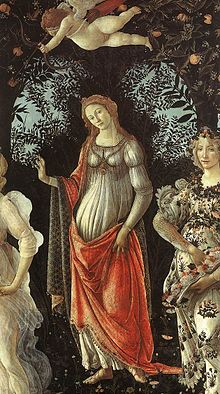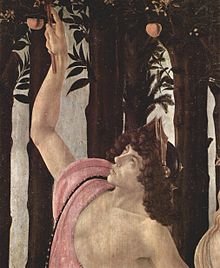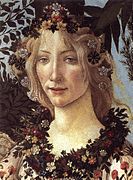Primavera (Botticelli): Difference between revisions
No edit summary |
m Undid edits by 98.242.9.6 (talk); rv to last version by Citation bot 1 — was correct before |
||
| Line 12: | Line 12: | ||
}} |
}} |
||
'''''Primavera''''', also known as '''''Allegory of Spring''''', is a [[tempera]] [[panel painting]] by Italian [[Renaissance]] artist [[Sandro Botticelli]]. Painted ca. 1482, the painting is described in |
'''''Primavera''''', also known as '''''Allegory of Spring''''', is a [[tempera]] [[panel painting]] by Italian [[Renaissance]] artist [[Sandro Botticelli]]. Painted ca. 1482, the painting is described in ''Culture & Values'' (2009) as "[o]ne of the most popular paintings in Western art".<ref name=CaR282>Cunningham and Reich (2009), p. 282.</ref> It is also, according to ''Botticelli, Primavera'' (1998), "one of the most written about, and most controversial paintings in the world."<ref name=Fossi5>Fossi (1998), p. 5.</ref> While most critics agree that the painting, depicting a group of [[mythological]] figures in a garden, is [[allegory|allegorical]] for the lush growth of Spring, other meanings have also been explored. Among them, the work is sometimes cited as illustrating the ideal of [[Neoplatonism|Neoplatonic]] love. |
||
The history of the painting is not certainly known, though it seems to have been commissioned by one of the [[House of Medici|Medici family]]. It contains elements of [[Ovid]] and [[Lucretius]] and may have been inspired by a poem by [[Poliziano]]. Since 1919 the painting has been part of the collection of the [[Uffizi Gallery]] in [[Florence]], [[Italy]]. |
The history of the painting is not certainly known, though it seems to have been commissioned by one of the [[House of Medici|Medici family]]. It contains elements of [[Ovid]] and [[Lucretius]] and may have been inspired by a poem by [[Poliziano]]. Since 1919 the painting has been part of the collection of the [[Uffizi Gallery]] in [[Florence]], [[Italy]]. |
||
Revision as of 06:08, 23 March 2011
| Primavera | |
|---|---|
| File:Primavera 01.jpg | |
| Artist | Sandro Botticelli |
| Year | c. 1482 |
| Typ | Tempera on panel |
| Standort | Uffizi, Florence |
Primavera, also known as Allegory of Spring, is a tempera panel painting by Italian Renaissance artist Sandro Botticelli. Painted ca. 1482, the painting is described in Culture & Values (2009) as "[o]ne of the most popular paintings in Western art".[1] It is also, according to Botticelli, Primavera (1998), "one of the most written about, and most controversial paintings in the world."[2] While most critics agree that the painting, depicting a group of mythological figures in a garden, is allegorical for the lush growth of Spring, other meanings have also been explored. Among them, the work is sometimes cited as illustrating the ideal of Neoplatonic love.
The history of the painting is not certainly known, though it seems to have been commissioned by one of the Medici family. It contains elements of Ovid and Lucretius and may have been inspired by a poem by Poliziano. Since 1919 the painting has been part of the collection of the Uffizi Gallery in Florence, Italy.
Composition

The painting features six female figures and two male, along with a blindfolded putto, in an orange grove. To the right of the painting, a flower-crowned female figure in a floral-patterned dress is scattering flowers, collected in the folds of her gown. Her nearest companion, a woman in diaphanous white, is being seized by a winged male from above. His cheeks are puffed, his expression intent, and his unnatural complexion separates him from the rest of the figures. The trees around him blow in the direction of his entry, as does the skirt of the woman he is seizing. The drapery of her companion blows in the other direction.
Clustered on the left, a group of three females also in diaphanous white join hands in a dance, while a red-draped youth with a sword and a helmet near them raises a wooden rod towards some wispy gray clouds. Two of the women wear prominent necklaces. The flying cherub has an arrow nocked to loose, directed towards the dancing girls. Central and somewhat isolated from the other figures stands a red-draped woman in blue. Like the flower-gatherer, she returns the viewers gaze. The trees behind her form a broken arch to draw the eye.
The pastoral scenery is elaborate. Botticelli (2002) indicates there are 500 identified plant species depicted in the painting, with about 190 different flowers.[3] Botticelli. Primavera (1998) says that of the 190 different species of flowers depicted, at least 130 have been specifically named.[2]
Themes

Various interpretations of the figures have been set forth, but it is generally agreed that at least at one level the painting is, as characterized by Cunningham and Reich (2009), "an elaborate mythological allegory of the burgeoning fertility of the world."[1] Elena Capretti in Botticelli (2002) suggests that the typical interpretation is thus:
The reading of the picture is from right to left: Zephyrus, the biting wind of March, kidnaps and possesses the nymph Chloris, whom he later marries and transforms into a deity; she becomes the goddess of Spring, eternal bearer of life, and is scattering roses on the ground.[5]
Venus presides over the garden, the Graces accompanying her (and targeted by Cupid) bearing jewels in the colors of the Medici family, while Mercury's caduceus keeps the garden safe from threatening clouds.[5] The basic identifications of characters is widely embraced,[6] but other names are sometimes used for the females on the right. According to Botticelli (1901), the woman in the flowered dress is Primavera (a personification of Spring) whose companion is Flora.[7] Flowers spring from Flora's mouth at the contact with the wind god.[8]
In addition to its overt meaning, the painting has been interpreted as an illustration of the Neoplatonic love popularized among the Medicis and their followers by Marsilio Ficino.[4][9] In this interpretation, as set out in Sandro Botticelli, 1444/45-1510 (2000), the earthy carnal love represented by Zephyrus to the right is renounced by the central of the Graces, who has turned her back to the scene unconcerned by the threat represented to her by Cupid. Her focus is on Mercury, who himself gazed beyond the canvas at what Deimling asserts hung as the companion piece to Primavera: Pallas and the Centaur, in which "love oriented towards knowledge" (embodied by Pallas Athena) proves triumphant over lust (symbolized by the centaur).[10]
History

The origin of the painting is somewhat unclear. It may have been created in response to a request in 1477 of Lorenzo de' Medici,[12] or it may have been commissioned somewhat later by Lorenzo or his cousin Lorenzo di Pierfrancesco de' Medici.[13][14] One theory suggests Lorenzo commissioned the portrait to celebrate the birth of his nephew Giulio di Giuliano de' Medici (who would one day become Pope), but changed his mind after the assassination of Giulo's father, his brother Giuliano, having it instead completed as a wedding gift for Lorenzo di Pierfrancesco de' Medici, who married in 1482.[5]
The painting overall was inspired by a description the poet Ovid wrote of the arrival of Spring (Fasti, Book 5, May 2), though the specifics may have been derived from a poem by Poliziano.[15][16] As Poliziano's poem, "Rusticus", was published in 1483 and the painting is generally held to have been completed around 1482,[2][17] some scholars have argued that the influence was reversed.[18] Another inspiration for the painting seems to have been the Lucretius poem "De rerum natura", which includes the lines, "Spring-time and Venus come, and Venus' boy, / The winged harbinger, steps on before, / And hard on Zephyr's foot-prints Mother Flora, / Sprinkling the ways before them, filleth all / With colors and with odors excellent."[19][20] It has been proposed that the model for Venus was Simonetta Vespucci, wife of Marco Vespucci and perhaps the mistress of Giuliano de' Medici, who is said to himself have been the model for Mercury.[11]
Whatever the truth of its origin and inspiration, the painting was inventoried in the collection of Lorenzo di Pierfrancesco de' Medici in 1499.[21] In 1919, it has hung in the Uffizi Gallery in Florence. During the Italian campaign of World War Two, the picture was moved to Montegufoni Castle about ten miles south west of Florence to protect it from wartime bombing.[22] It was returned to the Uffizi Gallery where it remains to the present day.[23] In 1982, the painting was restored.[24] The work has darkened considerably over the course of time.[16]
Notes
- ^ a b Cunningham and Reich (2009), p. 282.
- ^ a b c Fossi (1998), p. 5.
- ^ Capretti (2002), p. 49.
- ^ a b Deimling (2000), p. 45.
- ^ a b c Capretti (2002), p. 48.
- ^ cf. Phythian (1907), p. 214; Fossi (1998), p. 12; Mattner (2005), p. 23
- ^ Steinmann (1901), pp. 82-84.
- ^ Steinmann (1901), p. 82.
- ^ Connolly (2004), p. 25.
- ^ Deimling (2000), pp. 45-46.
- ^ a b Heyl (1912), p. 89-90.
- ^ Mattern (2005), p. 22.
- ^ Brown (2010), pp. 103-104.
- ^ Deimling (2000), p. 39.
- ^ Servadio (2005), p. 7.
- ^ a b Steinmann (1901), p. 80.
- ^ Patterson (1987), p. 65
- ^ cf. Cheney (1985), p. 52.
- ^ Deimling (2000), p. 43
- ^ Lucretius, transl. William Ellery Leonard.
- ^ Brown (2010), p. 104.
- ^ Tim Healey, Denis Healey: the artist within, The Guardian, Wednesday 5th January 2011, 20.30 GMT., and for the hard copy article, see page 10 of the G2 section of the Guardian of Thursday 6 January, 2011.
- ^ Connolly (2004), pp. 26, 28.
- ^ Connolly (2004), p. 44.
References
- Brown, Alison (2010). The Return of Lucretius to Renaissance Florence. Harvard University Press. ISBN 9780674050327. Retrieved 16 July 2010.
- Capretti, Elena (1 January 2002). Botticelli. Giunti Editore Firenze Italy. ISBN 9788809214330. Retrieved 16 July 2010.
- Cheney, Liana (1985). Quattrocento Neoplatonism and Medici humanism in Botticelli's mythological paintings. University Press of America.
{{cite book}}:|access-date=requires|url=(help) - Connolly, Sean (October 2004). Botticelli. Gareth Stevens. ISBN 9780836856484. Retrieved 16 July 2010.
- Cunningham, Lawrence S.; John J. Reich (16 January 2009). Culture & Values, Volume II: A Survey of the Humanities with Readings. Cengage Learning. ISBN 9780495569268. Retrieved 16 July 2010.
- Deimling, Barbara (1 May 2000). Sandro Botticelli, 1444/45-1510. Taschen. ISBN 9783822859926. Retrieved 16 July 2010.
- Fossi, Gloria (1998). Botticelli. Primavera (Inglese ed.). Giunti Editore Firenze Italy. ISBN 9788809214590. Retrieved 16 July 2010.
- Heyl, Charles Christian (1912). The art of the Uffizi Palace and the Florence Academy. L.C. Page. Retrieved 16 July 2010.
- Lucretius. On the Nature of Things at Project Gutenberg
- Mattern, Joanne (January 2005). Sandro Botticelli. ABDO Group. ISBN 9781591978398. Retrieved 16 July 2010.
- Patterson, Annabel M. (1987). Pastoral and ideology: Virgil to Valéry. University of California Press. ISBN 9780520058620. Retrieved 16 July 2010.
- Phythian, John Ernest (1907). Trees in nature, myth and art. Methuen & co. Retrieved 16 July 2010.
- Servadio, Gaia (2005). Renaissance Woman. I.B.Tauris. ISBN 9781850434214. Retrieved 16 July 2010.
- Steinmann, Ernst (1901). Botticelli. Velhagen & Klasing. Retrieved 16 July 2010.



